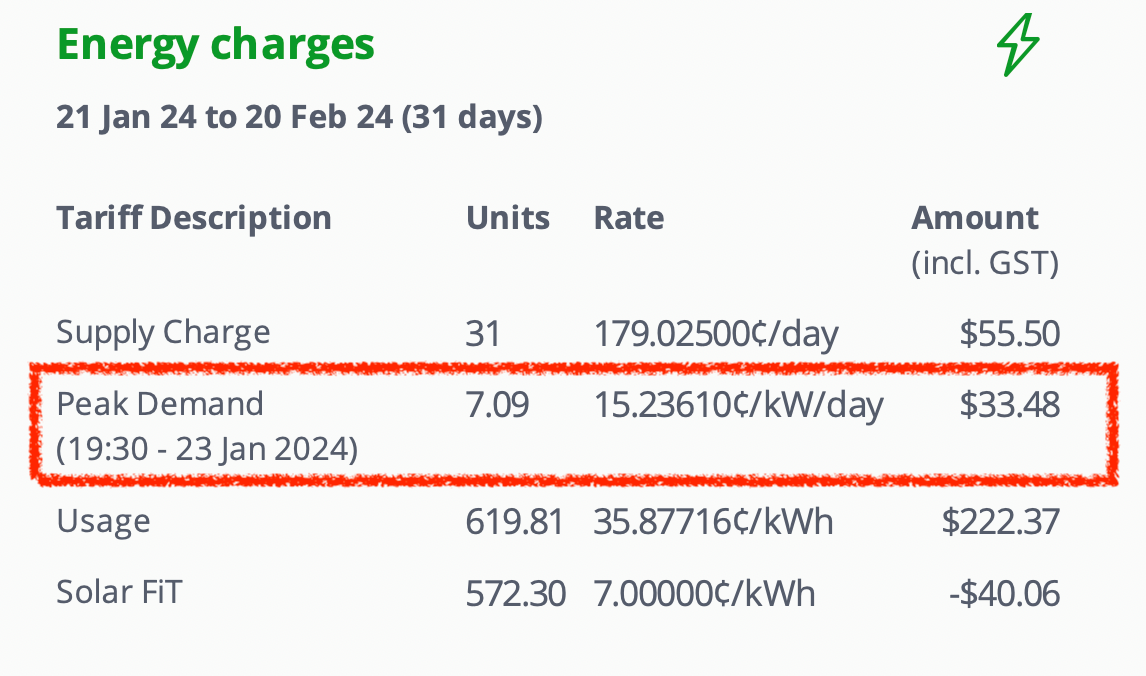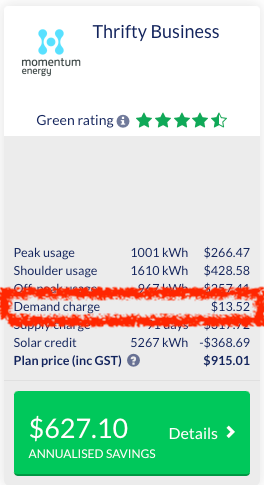Smart Meters are coming
The Australian Energy Market Commission (AEMC) is officially starting its Accelerating Smart Meter Deployment (ASMD) reforms. If you don’t already have a smart meter, you will by the end of 2030.
Demand tariffs are a new form of tariff intended to reward energy consumers who avoid contributing to peak network loads, and penalise that do. Here's everything you need to know

Have you spotted a strange new line item in your energy bill, charging you for 'Demand'? You're not alone. Here's the full explanation on everything you need to know, and how you can keep this new cost element in check.
Demand tariffs are a new and unwelcome addition to the retail energy bill for many Australian households. This article includes everything you need to know about what a Demand Tariff actually is, and how you can minimise your Demand expense.
Distributors have been migrating energy consumers onto Demand tariffs for several years already, and are now really picking up pace. It's likely that you'll be on a Demand tariff if you've had a smart meter installed within the last 4-5 years, which typically occurs when a solar system is installed, or if your old meter needed to be replaced. New-build properties will be set up with a smart meter from the start.
The clearest indicator that you're on a Demand tariff is your bill. If it includes a 'Demand' or 'Capacity' charge line item, then you're on a Demand plan.

Demand line item example form an OVO Energy bill
Our energy transmission and distribution networks are hugely expensive to build and maintain, but they're underutilised virtually all the time. The grid must be engineered to accommodate very high peak load events, such as the heatwave days in summer when numerous air conditioners generate huge spikes of demand all at once. However, these peak load events occur only a few times a year, so the grid is underutilised at all other times.
We need to maintain a high level of grid capacity; otherwise, the grid would become unstable, requiring 'load shedding', and consumers would experience power outages during periods of high demand.
Building out the infrastructure to support this peak demand is very expensive, and all of the costs ultimately land in all of our energy bills, so it makes sense to find ways to minimise those peak loads and apportion costs more toward those whose behaviour as energy consumers is driving those peak loads.
Shaving peak demand down even slightly can translate into significant savings at the aggregate level, and demand tariffs are one way to achieve this.
Demand tariffs are intended to deliver a 'price signal' to encourage individual consumers to spread out their peak time consumption and avoid intense usage spikes by shifting consumption out of peak times and into shoulder and off-peak times. The price signal consists of two parts: a reward in the form of cheaper rates per kWh, and a penalty in the form of a demand charge that scales according to the maximum load you create.
A demand tariff requires a smart meter. The tariff includes electricity usage and supply charges, just like any other tariff, and also includes an additional fee called a ‘demand’ or ‘capacity’ charge. The demand charge is an additional charge per kW, based on the maximum peak consumption recorded during any 'Demand window' time periods over the course of a billing period.
Demand charges are applied based on the highest recorded demand for every day in the billing period. So you only need to over-consume once to find yourself paying penalty Demand fees over an entire billing period.
Demand tariffs differ significantly from how most of us are accustomed to paying for electricity. If you have a good understanding of your electricity consumption patterns and are willing and able to monitor and adjust your usage, then a demand tariff could save you money. If not, it could cost you a lot more.

Under a single-rate tariff structure, both households would pay the same amount, since they both used the same amount of electricity over the billing period.
Under a demand tariff, Household B will pay a higher demand charge related to the intensity of the load their 24 heaters placed on the grid simultaneously.
Demand charge is applied on top of the familiar per-kWh usage charges, and is calculated on your highest level of consumption measured during the 'demand window', which is typically between 3pm and 9pm.
The main potential benefit to individual consumers of demand tariffs is that the general usage rates under a demand tariff should be lower than the usage rates on a single rate tariff. If you're careful about managing your peak demand, you may be able to pay less under this type of tariff.
A demand tariff introduces additional pricing risk to energy consumers, and it is suitable only for households with a good understanding of demand patterns and a solid ability to manage that demand effectively.
Demand tariffs can be punishing for households that take their eyes off the ball and let their electricity usage spike for even a single moment. They'll pay a price penalty for the entire billing period.
It's possible that a demand tariff could save you money, but it will require you to stay vigilant in monitoring your power usage to avoid spikes and adopt efficient energy usage practices.
Typically, this means minimising your overall appliance usage during peak times and also minimising the intensity of your usage during peak times.
Minimise the demand charges in your bills by time-shifting your usage out of Demand window times, and by 'daisy-chaining' any unavoidable usage during Demand window times.
What this means in practice is to shift all your discretionary usage out of the Demand window times, and to daisy-chain your non-discretionary usage.
For example, you could run your dishwasher and washing machine either earlier in the day or late at night, so the consumption from these appliances will not contribute to your Demand window usage at all.
For other activities and appliance usage that cannot realistically be time-shifted out of the Demand window, eg cooking in the evening, try to avoid the simultaneous use of appliances within a single 30-minute pricing period, by daisy-chaining these activities sequentially.
After significant criticism about the rollout of cost-reflective tariffs in Australia, the AEMC has acknowledged the problems faced by many energy consumers and announced significant reforms to the rollout of the new cost-reflective tariffs:
Implementing the flat-rate tariff provision will require individual states and territories to update their respective regulations to align with this national directive.
In Australia, the electricity distributors are now progressively moving customers onto demand tariffs. The roll-out approach varies by state and distribution zone, as does the detailed structure of the demand tariff.
Depending on your location, demand charges will be applied:
The demand rate can change by season
Since 1 July 2019, demand tariffs have been assigned by default for:
Demand (introductory) tariffs are intended to allow customers to better understand their patterns of usage for 12 months, before they will be automatically assigned to the default demand tariff. Customers assigned to the demand (introductory) tariff have the option to be reassigned to another demand tariff, or to a TOU tariff.
A new TOU-demand and existing TOU tariffs are available for customers who opt out of a demand tariff. TOU customers replacing meter for any reason will remain on TOU tariffs, and can opt-in to demand tariffs.
Flat tariffs are no longer available to new connections.
Demand Structure and Charge Window
The demand element is based on the maximum energy consumption recorded in any 30-minute period within the defined seasonal demand window on a working weekday in each billing period (measured in kW). The resulting demand charge applies for each day in the billing period (before being reset for the next month).
The demand window for measuring the maximum demand is aligned with a corresponding TOU peak energy window. In seasons where there is no peak energy on working weekdays, a summer window of 2-8 pm applies.
More information is available in Ausgrid's Demand Tariff Q&A and Fact Sheet documents.
Endeavour Energy is introducing both a transitional demand tariff and a ‘cost reflective’ demand tariff intended to provide flexibility for customers to select the pace of their transition.
The transitional demand tariff will become the default tariff for all new customers and those existing customers with the required metering who upgrade their network connection to three-phase or fro bi-directional flow of electricity after installing solar. Customers assigned to the transitional demand tariff will have the option to opt-out to the flat energy based tariff or the seasonal time of use tariff.
The cost reflective demand tariff will be available to all customers on an opt-in basis subject to metering requirements.
Endeavour’s demand tariffs consist of three tariff parameters: a seasonal maximum monthly demand charge, a flat energy charge and a fixed charge.
Essential Energy’s demand tariffs are available on an opt-in basis for customers who have an interval or smart meter.
Each Essential Energy network tariff is made up of one or more of the following components:
See Essential Energy demand tariff brochure for additional information.
Demand tariffs are available on an opt-in and opt-out basis for residential customers with consumption less than 60 mWh per annum, or peak demand less than 120 kW.
Demand is based on the maximum demand (kW) in each month that is recorded between 3pm and 9pm on work days with no minimum chargeable demand level (except in the United Energy zone where a minimum monthly chargeable demand of 1.5kW applies).
Residential customers can move to a demand tariff on an opt-in basis provided they have the appropriate metering technology.
Demand charges for residential customers are based on the maximum demand in any half-hour trading interval since the last meter read:
If a retailer does not specify its preferred network tariff for a new customer, Energex will assign the customer to the Residential Transitional Demand tariff.
If a customer classification is not received from the retailer for move-in small customers, the retail customer moving-in to the existing premises will inherit the existing customer classification and existing network tariff. Move-in customers are not considered as a new customer to Energex, as these customers are not a new connection to the distribution network.
Energex will initiate network tariff reassignment of customers in the following instances:
Demand charges for residential customers are calculated as a $/kVA/month or $/kW/month, for demand recorded at a connection point. These charges are applied to the maximum half hourly kW power reading that occurred at a connection point during either:
The data present in your bill is specific to the tariff type you are on. Bill Hero comparisons are based on the data present in each bill.
If you are already on a demand tariff Bill Hero will compare your bill, including the demand tariff component with the alternative demand plans available to you from all retailers.

Not a subscriber yet? What are you waiting for! Never overpay for energy again! Bill Hero automatically compares every bill to help keep you always on the best priced plan.
When you upload a Demand tariff bill, look out for the Demand component that will be itemised in the alternative plans compared for you.

As with all other bill components, Bill Hero ranks the plans according to the calculated overall price for each plan, not by Demand or any other individual component.
Savings as a Service is the blog site and newsletter from Bill Hero. Subscribe now and get your energy savings tips and information delivered fresh to your inbox every month.